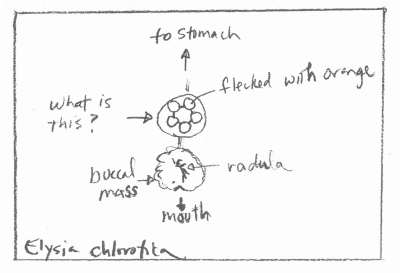Elysia anatomy
November 13, 2003
From: Kathleen Archer

Dear Colleagues,
I'm studying the digestive tract of Elysia chlorotica as part of a project to better understand how chloroplasts of Vaucheria litorea can survive ingestion and function within the animal (see the "Solar-powered Sea Slugs" area). I have a diagram of Elysia (formerly Tridachia) crispata (from Richard Fox's dissection exercise on the web)that I am using as a guide to identify organs and structures. However, there is one organ that doesn't seem to correspond to anything in Richard's diagram. I have included a jpeg image to help show what I will describe here. Starting at the mouth and progressing towards the posterior, I first encounter the buccal mass with the radula. The very next structure is a sphere about the same size as the buccal mass. Inside this sphere are 5 (usually) smaller spheres, and these are interconnected with each other by ductwork. They are flecked with orange, so that the organ is readily detected under the dissecting scope. Can anyone suggest what this structure might be?
Thanks,
Kathleen Archer
kathleen.archer@trincoll.edu
Archer, K., 2003 (Nov 13) Elysia anatomy. [Message in] Sea Slug Forum. Australian Museum, Sydney. Available from http://www.seaslugforum.net/find/11392Dear Kathleen,
What you have is the nerve ganglia which forms a ring around the oesophagus - sometimes loosely called a 'brain'. There are 4 main ganglia - a pair of dorsal cephalic ganglia and a pair of ventral pedal ganglia. In each ganglion there is a set of interconnected nerve cells which form a 'mini-brain'. The flecks of orange you describe are the individual nerve cells which are usually brightly coloured [in you animal they are apparently orange]. The position of individual nerve cells is very constant. This is the reason that the sea hare, Aplysia californica, has become such an important laboratory animal. With such large, easily mapped, individual cells it has become a favourite animal for those studying how brains work.
Best wishes
Bill Rudman
Related messages
-
Lateral gene transfer between multicellular organisms
From: Bill Rudman, August 15, 2007 -
Elysia chlorotica "ghosts".
From: Skip Pierce, June 15, 2005 -
Elysia chlorotica from Martha's Vineyard, USA
From: skip pierce, May 14, 2005 -
New Paper on Elysia chlorotica
From: Elizabeth J. Summer, September 22, 2000 -
Trouble finding Elysia chlorotica
From: Jack Teng, August 4, 2000 -
Re: Elysia chlorotica & mating chains
From: Kathe R. Jensen, May 18, 2000 -
Elysia chlorotica & mating chains
From: Liz Summer, May 17, 2000 -
Re: Elysia sp. 7 from Texas
From: Kathe R. Jensen, May 7, 2000 -
Solar-powered Elysia chlorotica
From: Liz Summer, February 26, 2000 -
Elysia from Texas
From: Cathy Porter, February 23, 2000
